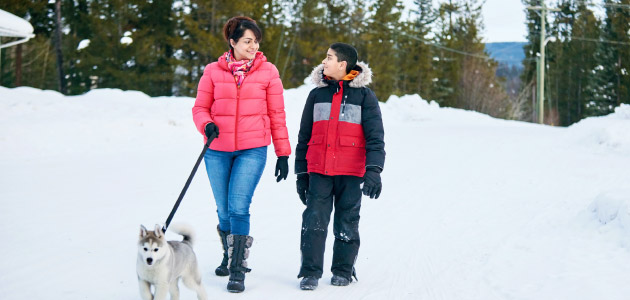Winter brings both opportunities and challenges when it comes to staying healthy and safe. The following suggestions can help you sail through winter feeling strong and empowered, no matter what the weather throws at you.
Get your vitamin D. Known as the “sunshine vitamin” because we absorb this essential nutrient through exposure to the sun, it can be challenging to get the right amount of vitamin D in the winter. The days are shorter and we’re generally bundled up, so there’s less opportunity for sun exposure. But in addition to helping us maintain stronger bones and teeth, vitamin D can be help with battling seasonal depression1, so it’s worth talking to your doctor to find out if you should be taking vitamin D supplements, and if so, how much.
Shovel safely. It’s important to talk to your doctor to find out if it’s safe for you to shovel snow, since it is a strenuous activity that can cause injury. The National Safety Council2 recommends the following precautions when shoveling snow:
- Don’t shovel snow immediately after eating or while smoking
- Go slowly, and stretch to warm up before you begin
- Shovel fresh, powdery snow and push heavier snow rather than lifting it
- Lift with your legs, not your back, to avoid back strain and injury
- Don’t work to the point of exhaustion
- Know the signs of a heart attack, stop right away and call 911 if you’re experiencing any of them
Walk carefully. When you have to walk on snow and ice, always make sure you’re wearing proper footwear. Boots and shoes made with rubber and neoprene composite provide better traction than plastic and leather soles. Flat soles are also much safer to wear, so skip the heels in winter conditions.3 Take short steps or shuffle, bend slightly forward and walk flat-footed with your center of gravity over your feet as much as possible. This short video explains how walking like a penguin may help keep you safer when walking on icy surfaces.
Keep moving. Cold, blustery weather can keep us from going outside to get exercise, so find ways to keep moving even when you don’t want to, or can’t, leave your home. Online fitness classes are a great idea, but you can also add extra movement to everyday chores and habits, like doing lunges on the way to the bathroom and squats while you’re brushing your teeth. If you’re seated for longer periods, try setting a timer to make sure you get up at least once an hour to move your body or trying walking or jogging in place during commercial breaks when you’re watching television.
Eat healthy comfort foods. We tend to indulge in creamier, richer meals and treats when the weather turns colder. Try lightening up comfort-food favorites with healthy substitutions and healthier cooking techniques like using spiralized vegetables instead of pasta, baking instead of frying, or swapping yogurt for mayonnaise or sour cream.
Take precautions when you do venture out. Wear a mask, wash your hands regularly, carry hand sanitizer for when you can’t use soap and water, don’t touch your face, and always follow the guidelines of your local health authority in order to keep yourself and others as safe as possible.
SOURCES
- https://globalnews.ca/news/3954605/vitamin-d-canada-winter-food-supplements/
- https://www.nsc.org/home-safety/tools-resources/seasonal-safety/winter/snow-shoveling
- https://www.ehs.iastate.edu/weather/winter/walking
419594 CAN/US (02/21)




